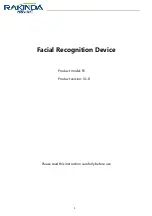
Page 12 of 18
Brüel & Kjaer Vibro
●
10/2019
●
C107097001/V02
Technical alterations reserved!
EN
3 Measuring Principle
The acceleration sensor operates according to the piezo-electric principle. A piezo-element and an internal
sensor mass form a spring-mass system in the sensor.
If this system is subjected to vibrations the mass produces an alternating force on the piezo element. As a
result of the piezo effect an electrical charge is produced that is proportional to vibration acceleration. An
integrated amplifier converts this charge signal into a usable voltage signal.
4 Mounting
4.1 Coupling
General rule:
The weight of the acceleration sensor should always be lower at least by a factor ten than the weight of the
object onto which it is mounted.
The acceleration sensor is an additional mass, which loads the object on which it is mounted, and this changes
the vibration behaviour if it is too large. The sensor requires a friction-locked, contact resonance-free, rigid
mounting to the object, particularly for measurements at high frequencies. The cable must be attached on a
non-tension basis and load-free in connection.
Figure 4-1)
Mounting (all length in [mm])
The sensor must be mounted with the enclosed screw (M6). The mounting position on the machine is arbitrary.
1.
The mounting surface must be machined flat in the area of the sensor (roughness depth
0.8 µm, flatness 0,05 mm) and have a minimum diameter of 65 mm.
2.
Supply installation surface with threaded bore M6 according to drawing (fig.4-1).
3.
The bore must be countersunk and cleaned.
4.
Turn in the
Screw into installation surface according to drawing (fig. 4-1) and secure
(LOCTITE 243 intermediate strength or LOCTITE 270 high strength).
5.
Apply thin layer of silicone grease to the installation surface to reduce contact resonance.
6.
Screw sensor onto the threaded stud with a mounting torque of 3.5 Nm and secure
(LOCTITE 243 medium strength or LOCTITE 270 high strength).




































